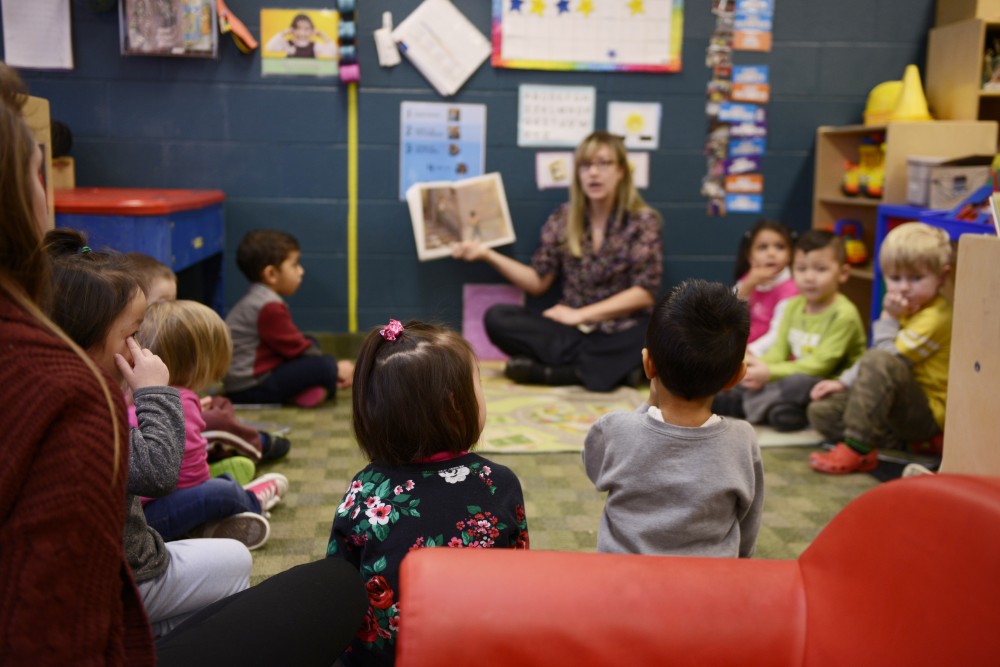As University-area daycare centers face funding losses from student service fees next school year, student-parents and center directors are working to find alternative ways to fund childcare services.
The Como Early Learning Center and Community Child Care Center — daycares that primarily serve University of Minnesota parents — have each received about $85,000 from student service fees in years past. Because of a new cap set for groups, each center will be eligible for a maximum of $55,000.
Directors from the daycares and student-parents say the drop in funding could result in cutting : a sliding scale that discounts daycare services based on parents’ income.
Though the University is attempting to alleviate decreased funding by offering a grant for student-parents, advocates say the grant — which the University has said has a funding pool of at least $100,000 — is less effective at helping individual parents than the sliding scale.
On March 20, the Council of Graduate Students general assembly passed a resolution criticizing the grant and calling for greater support for the daycares from the University.
The resolution states that the changes to the SSF process have “effectively decimated the ability [of the centers] to serve the [University] community.” It calls the grant “completely inadequate.”
Leaders from the daycares have met with administrators and the Office of Student Affairs to continue to voice their concerns about the SSF changes. However, there’s been little indication that the University will increase funding for the centers, said Katie Johnson, director of the Como Early Learning Center.
Other campus groups, such as the University of Minnesota Child Development Center and the Student Parent Help Center,have joined the centers’ advocacy efforts, Johnson said.
“The parents are very upset. They’re very worried,” she said, adding that many parents have written letters to the president’s office.
The University did not make Vice Provost for Student Affairs Danita Brown Young available for comment. Instead, it sent a copy of a letter the office sent to daycare advocates, which is signed by Brown Young.
“While we have been happy to provide this level of funding in the past, we also know that not all of our student parents seek child care at the CCCC and CECL. In addition, we are working to respond to overall concerns about the rising cost of the SSF and have made concerted efforts to reign in these fees on behalf of all of our students,” the letter says.
Some graduate students are now upset because SSF has been so central in aiding daycare funding in the past, said Erin Evans, co-author of the resolution and COGS legislative director.
The fee changes are leading the centers to explore alternative funding such as fundraising and applying for grants, said Johnson.
“[We’re trying] to come up with scholarship money for the student parents who will lose that discount because of the student service fee cuts,” she said.
Johnson said the CELC is currently going through the SSF process, and in their initial recommendation received the maximum $25,000 in operational fees funding. The rest of the funding will be determined in October meetings she said.
The impact of the fee changes on the centers is fostering uncertainty for parents who are already struggling to afford the high cost of child care.
Hank Stabler, a second-year doctoral student in health services research, lives with his family at the Como Student Community Cooperative, and his two kids go to the built-in Como Early Learning Center.
With a 25 percent discount from the sliding scale, his family can only afford to send both his kids to the center part-time.
With the loss of the sliding fee scale, he said they may need to explore other options.
“We’ll have to do some real book-balancing to see if it’s worth it for my wife to work part time or [if she would] have to take care of the kids full time,” he said.
Nadia Pedersen, whose four-year-old daughter goes to the Como Early Learning Center, said the state offers other forms of aid, but these often have long waitlists.
“It’s like a second tuition to pay for daycare,” she said. “[The grant] wouldn’t really make a dent at all.”








